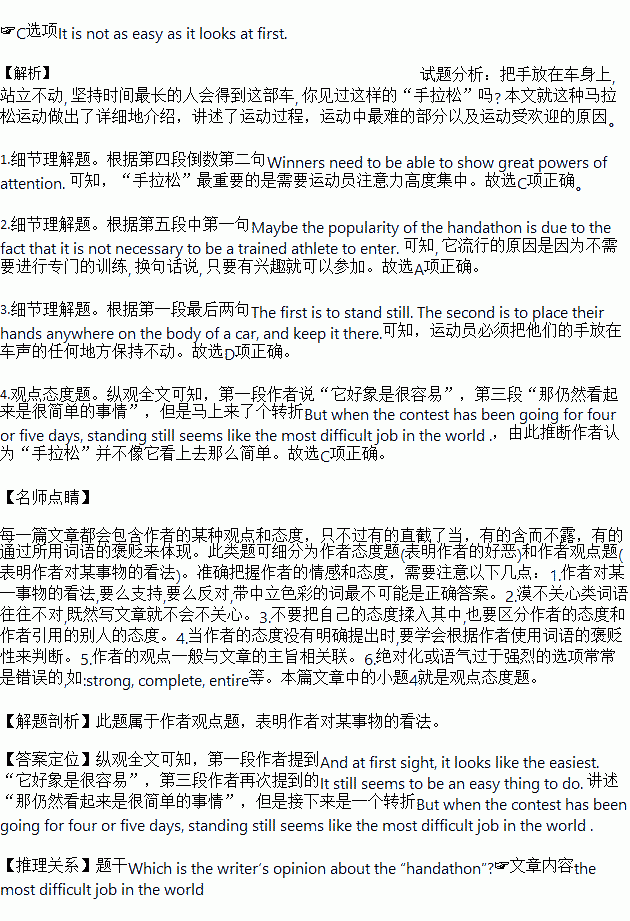题目内容
It is probably the strangest sport anyone has ever invented. And at first sight, it looks like the easiest. Competitors have to do two things. The first is to stand still. The second is to place their hands anywhere on the body of a car, and keep it there.
This is where things start getting difficult. Lots of people are doing the same thing. And the winner of the “handstand” contest is the person who can carry on doing it for the longest time. That person gets to own the car.
It still seems to be an easy thing to do. At the beginning it is. Anyone can stand still. But when the contest has been going for four or five days, standing still seems like the most difficult job in the world . And keeping the hand in place over this time becomes an act of serious attention. After a few days, the hand seems to belong to someone else----someone who wants to go home and get some sleep.
Competitors are allowed to take a five-minute break every hour to eat, drink or do whatever else is necessary. No one is allowed to lean on the car for support. Winners need to be able to show great powers of attention. They also need to be able to develop special skills.
Maybe the popularity of the “handathon” is due to the fact that it is not necessary to be a trained athlete to enter. Competitors in the Longview handathon certainly don’t seem to do much preparation. Most say they will prepare by “getting lots of sleep”. Others say they will “eat healthy food” or “pray for success”. The whole event gives ordinary people the chance to do something interesting and win something in the end.
Handathons are competitions, but there is little rivalry (竞争) between competitors. They help each other out and keep each other’s spitits up. People who drop out early return with food, drink and encouragement.
1.What ability is most important in a handathon?
A. Not leaning on the car B. Standing without any support
C. Having strong powers of attention D. Eating and drinking in five minutes
2.Why is handathon popular?
A. Anyone who is interested can join in it.
B. Someone can win with special training
C. It doesn’t need to make any preparation
D. People get along well with each other in it.
3.Which of the following statements about the “handathon” is right?
A. Competitors are not allowed to drop out
B. Competitors don’t encourage each other
C. Competitors can sit down and take a 10-minute break every hour
D. A competitor has to place his or her hand anywhere on the body of a car.
4.Which is the writer’s opinion about the “handathon”?
A. It is the easiest of all sports.
B. It can last a whole day.
C. It is not as easy as it looks at first.
D. It is no good competing in a “handathon”
 阅读快车系列答案
阅读快车系列答案

 listed above all else. Apprenticeships(学徒工作) were considered as a choice for dropouts(辍学者) rather than a brave career choice. Some young men and women didn’t fit into the school system, but preferred to find new starts, so they were allowed to leave school to focus their attention on making a living in the business world.
listed above all else. Apprenticeships(学徒工作) were considered as a choice for dropouts(辍学者) rather than a brave career choice. Some young men and women didn’t fit into the school system, but preferred to find new starts, so they were allowed to leave school to focus their attention on making a living in the business world.